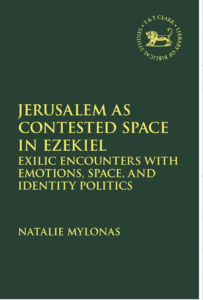Research
Current Projects
Emotions of exile: The role of place attachment in ancient Israelite spatial ideologies and identity formation (Funding: ASCS Early Career Award, 2023)
- The primary aim is to undertake a comparative study of portions of Ezekiel, Jeremiah, and Isaiah to determine how competing ideologies of place evoke emotion in order to shape Israelite place attachment and identity during a time of unpreceded crisis.
- The project includes the following components:
- Establishing a theoretical framework for researching place attachment in biblical literature. This will be informed by transdisciplinary research in the social sciences, psychology, and environmental sciences.
- Mapping spatial representations of the city Jerusalem and the land of Israel in portions of Ezekiel, Jeremiah, and
- Identifying discrete emotions that influence place attachment through these spatial representations, especially longing, hope, fear, shame, disgust, and grief.
- Evaluating how place attachment intersects with ideology to shape Israelite identity during this formative period of the Hebrew Bible.
Publications
Natalie F. Mylonas, “Emotions and Prophecy,” in (eds.) Ari Mermelstein and Katherine M. Hockey, T&T Clark Handbook of the Bible and Emotion (London: T&T Clark, forthcoming).
Emotions are present at virtually every stage of biblical prophecy, from the moment the prophet receives a message from God, through to the delivery of this communication and its reception by an audience. As a channel of communication between the God of Israel and humanity, biblical prophecy effectively harnessed the persuasive power of emotions in order to mediate, mend, and negotiate divine-human relations. This chapter explores the retributive and rehabilitative function that emotions play in prophecy, examines some techniques biblical prophecy uses to provoke emotions in the audience, and outlines the ways that emotions move between subjects in biblical prophecy. The chapter begins by providing a framework for considering emotions and by explaining the relationship between emotion and the genre of prophecy. Then it turns to consider the ways that biblical prophecy is designed the evoke strong emotions in the audience through a case study of kinship metaphors. The chapter concludes by exploring the important role of emotions like grief, shame, fear, and hope in repentance, judgement and restoration.
Natalie F. Mylonas, Jerusalem as Contested Space in Ezekiel: Exilic Encounters with Emotion, Space, and Identity Politics (The Library of Hebrew Bible/Old Testament Studies) (London, Bloomsbury: 2023)

Natalie Mylonas uses Ezekiel 16 as a case study in order to reveal the critical relationship between space, emotion, and identity politics in the Hebrew Bible. Drawing on interdisciplinary research that emphasises how space and emotions are inextricably linked in human experience, Mylonas explores the portrayal of Yhwh’s wife, Jerusalem, in Ezekiel 16 as a personified city who feels. In order to deliver its argument, the book foregrounds purity and gender issues, as well as debates on emotions in the Hebrew Bible, emphasising that spatiality is a key component of how these issues are conceptualised in ancient Israel.
Mylonas argues that the power struggle between Jerusalem and Yhwh in Ezekiel 16 is a struggle over the contested space of Jerusalem’s body and the city space. Jerusalem’s emotions are in a dynamic relationship with the spaces in the text – they signified by these spaces, they shift as the constitution of the spaces shifts, and they are shaped by Jerusalem’s use of space. Jerusalem’s desire, pride, and shamelessness are communicated spatially through her use of city space, while her representation as disgusting is underscored by her “uncontrollable” female body. Mylonas concludes by showing how Ezekiel’s vision of the new Jerusalem in Ezekiel 40-48 re-establishes sacred space through the erasure of the feminine city metaphor coupled with strict boundary policing, which is a far cry from the assault on Jerusalem’s boundaries described in Ezekiel 16.
Natalie F. Mylonas, “Erasing Alterity: Gendered Characterisation in the Different Versions of vita anastasiae,” Journal of the Australian Early Medieval Association, vol. 13 (2017): 19-46
Despite official declarations against cross-dressing in the fourth century, eleven vitae that praise the ascetic superiority of female assigned saints who dressed like men were produced in late antiquity. Engaging in a practice that was explicitly forbidden by numerous ecclesiastical synods, these individuals were often labelled as ‘others’ because they resisted social expectations and gender norms and trespassed into the masculine realms of independence and holiness. This study examines the gendered representation of one of these saints named Anastasia/Anastasius. It traces the gendered representation of the saint across three versions of their Greek vita, two of which are preserved in Vita Danielis and one in the Greek ‘Menaion’. These texts are fascinating because of the differing degrees to which they tolerate and promote the gender ambiguity of the saint. While the former versions allow Anastasia/Anastasius a degree of gender ambiguity, the ‘Menaion’ version suppresses much of this ambiguity. I will demonstrate this by exploring three aspects of Anastasia’s/Anastasius’s gendered characterisation in the texts: 1) designations for the saint throughout each narrative; 2) the saint’s identification as a eunuch; and 3) the degree of agency attributed to the saint. I conclude by offering some thoughts about how alterity theory can help account for these different representations, which I argue are responses to the perceived alterity of the saint.
Natalie F. Mylonas, Stephen Llewelyn & Gareth J. Wearne, “Speaking to One’s Heart: דבר and Its Semantic Extension,” Journal of Hebrew Scriptures, vol. 16 (2016): 1-26. https://doi.org/10.5508/jhs.2016.v16.a7
Cognitive linguists are increasingly recognising the value of metonymy for understanding the way language works. This article applies recent advancements in the theory of metonymy to the Hebrew noun דבר in order to explain its broad semantic range. It argues that metonymy and its function in the processes of grammaticalization account for the majority of lexical senses listed for דבר. It also aids in the translation of this polysemous noun by highlighting some contextual features of speech that help determine the meaning of דבר in any given sentence.